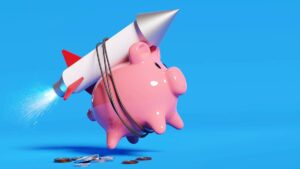Here’s how you can cash in on interest rates moves through ‘Carry Trades’ and Currency ETFs

- The turmoil in the rates market offers opportunities in currency trading
- The long USD trade has been the theme this year, but can it continue?
- Stockhead reaches out to Betashares’ chief economist David Bassanese on how investors can get currency exposure through ETFs
The ASX 200 is down 5% this year, but here’s one trade that would have made you a very good return over the last 12 months.
If you had bought USD (and sold AUD) a year ago and converted back to AUD today, your return would be around 10%.
It would have been as high as 20% a couple of weeks ago had it not been for the large drop in USD following the US inflation report.

Over the last 12 months, the almighty USD has appreciated against all major currencies, including the AUD.
This move has demonstrated to us that a currency’s value is very much tied to the differentials in interest rates between countries.
Risk capital is always looking for higher yielding assets and that’s exactly what’s happened with the USD this year.
Since March, the US Fed has hiked its funds rate by 3.75% – from 0.25% to 4% – to quell runaway inflation at home.
And it’s been doing it at a pace and size not seen since 1980s, much faster than its peers.
Here’s a quick comparison of what the major central banks have done in 2022.
| Central bank | Rate Hike in 2022 |
|---|---|
| US Fed | +3.75% |
| Euro ECB | +2.0% |
| Britain BoE | +2.75% |
| Japan BoJ | 0% |
| Australia RBA | +2.75% |
The US Fed has effectively widened the gap between its own rates and other countries, attracting capital inflow and “one-way bets” on the US dollar.
“I think the Fed is going to continue to raise rates relatively aggressively compared to other countries,” Betashares’ chief economist, David Bassanese, told Stockhead.
“I believe the next focus for the market would be the growth slowdown caused by the higher interest rates.
“What you may well see in that environment is that the US dollar will remain pretty strong, which won’t favour the Aussie dollar,” Bassanese added.
‘Carry trade’
Here’s another forex trade you could do to extract value from rates differentials.
It’s called the “carry trade”.
The idea is here is to sell a currency where the rates are lower, against buying a currency where the rates are higher.
As a simple example, if you put on a long USD/AUD forex position through a broker (buy USD and sell AUD), you would earn daily interest on your USD balance, and pay daily interest on your short AUD balance.
Since US rates are higher than Aussie rates, you will earn what’s called a “positive carry”.
This daily interest will be earned on your brokerage account until you close out your position.
Roughly speaking, the daily rates (or your net carry) are calculated in this way:
Daily interest = (Rates of long currency – Rates of short currency) / 365 x Notional value of your position
It’s not a surprise that the Japanese Yen has been the poster child for carry trading for at least the last decade.
With its perpetually ultra low interest rates of just 0.1%, the Yen is the perfect currency to execute the funding leg (short currency) of this trade.
For example, if you put on a long AUD/short JPY forex position, you would be accruing a net daily positive interest on your position simply because Aussie interest rates are higher.
“And if you were long the US dollar funded by the short Yen this year, you would have got a nice interest rate pickup, as well as profits from USDJPY currency moves,” explained Bassanese.
“So there’s an example where the carry trade has worked very well this year.”
Depending on the size of your position, this daily carry could be small but what happens when leverage is used? (Not that we recommend leveraged trading.)
A carry trade however is not all about earning interest. It’s also important to note that at the end of the day, you would still incur daily marked-to-market profits or losses on your forex position as the market moves.
Most recently, the AUD has been increasingly used as a funding (short) position on emerging market forex trades.
As the RBA pivots into a less aggressive rate hike, emerging-market carry trades funded by the Aussie dollar have increased.
Trades such as the HUF/AUD (long Hungarian forint vs short AUD), PLN/AUD, ARS/AUD are giving traders a huge net positive carry due to the rates differentials.
A cheaper alternative via Currency ETFs
Betashares offers currency exchange-traded funds (or ETFs) for ASX investors interested in gaining exposure to the performance of a particular foreign currency relative to the Aussie dollar.
Bassanese explains that these funds offer a cheaper alternative to investors who want to dabble in the currency markets.
“Through these ETFs, you can buy and sell currencies as easily as a share on the stock market.
“It’s just a cheap and easy way to get a currency exposure compared to setting up a new foreign currency bank accounts for example.
“And plus, you can easily get the leveraged exposure that we’re offering,” he said.
Betashares currently offers five currency funds:
Non-leveraged currency ETFs
BetaShares US Dollar ETF (ASX: USD)
This fund offers a low-cost way to access the performance of the US dollar relative to the Aussie dollar.
In other words, the fund will be long USD and short the AUD, with no leverage.
It’s a simple fund. For example if the US dollar goes up 10% against the Australian dollar, the return on the USD is designed to go up 10% too, before fees and expenses.
Management costs are 0.45% p.a.
Over the past 12 months, the fund has returned 12.64%.
Betashares British Pound ETF (ASX:POU)
This fund offers a low-cost way to access the performance of the British pound relative to the Aussie dollar.
In other words, the fund will be long GBP and short the AUD, with no leverage.
If the GBP goes up 10% against the Australian dollar, the return on the GBP is designed to go up 10% too, before fees and expenses.
Management costs are 0.45% p.a.
Over the past 12 months, the fund has returned -6.81%.
Betashares Euro ETF (ASX:EEU)
Again, this fund offers a low-cost way to access the performance of the Euro relative to the Aussie dollar.
In other words, the fund will be long EUR and short the AUD, with no leverage.
If the EUR goes up 10% against the Australian dollar, the return on the GBP is designed to go up 10% too, before fees and expenses.
Management costs are 0.45% p.a.
Over the past 12 months, the fund has returned -6.06%.
Leveraged currency ETFs
Betashares also offers two riskier, leveraged currency funds.
Betashares Strong Australian Dollar Fund (Hedge Fund) (ASX:AUDS)
The AUDS fund aims to provide geared (or leveraged) exposure to changes in the value of the Australian dollar against the US dollar.
The fund is long AUD and short the USD on a leverage of 2x to 2.75x.
AUDS invests in cash and cash equivalents and buys AUD/USD exchange-traded futures contracts to obtain its geared exposure.
Management fee is at 1.19% per annum.
Due to the leveraged nature, this is a risker fund and over the last 12 months, the fund has returned -31%.
BetaShares Strong US Dollar Fund (Hedge Fund) (ASX:YANK)
The YANK fund is the reverse of the AUDS fund.
The YANK fund aims to provide geared (or leveraged) exposure to changes in the value of the US dollar against the Australian dollar.
The fund is long USD and short the AUD on a leverage of 2x to 2.75x.
YANK invests in cash and cash equivalents and sells AUD/USD exchange-traded futures contracts to obtain its leveraged exposure.
Management fee is at 1.19% per annum.
Due to the leveraged nature, this is a risker fund and over the last 12 months, the fund has returned +28.82%.
Share prices today:
The views, information, or opinions expressed in the interview in this article are solely those of the interviewee and do not represent the views of Stockhead.
Stockhead has not provided, endorsed or otherwise assumed responsibility for any financial product advice contained in this article.
Related Topics
SUBSCRIBE
Get the latest breaking news and stocks straight to your inbox.
It's free. Unsubscribe whenever you want.
By proceeding, you confirm you understand that we handle personal information in accordance with our Privacy Policy.








